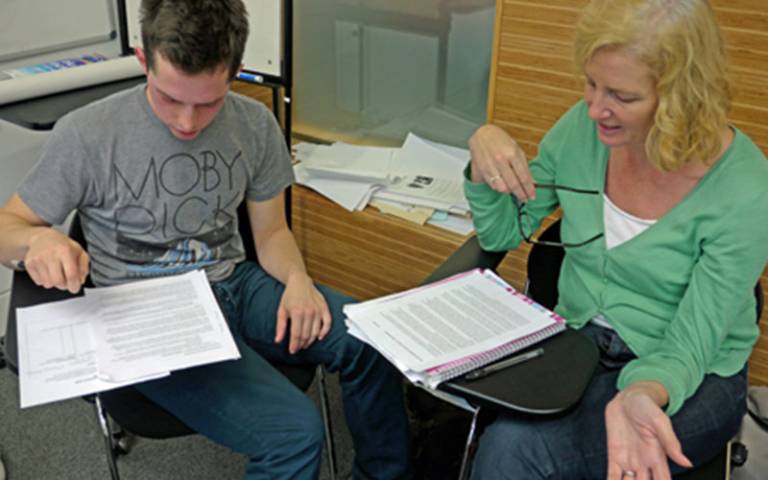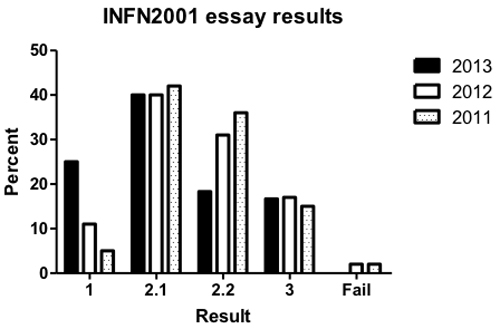Peer review of virology essays
Dr Richard Milne, from the Centre for Virology, explains how introducing a peer review system helped improve his students' essay marks by an average of one degree class.

7 August 2013
Richard describes how he introduced the concept of peer-reviewed papers to his students' essay writing.
"I was really disappointed with the quality of coursework essays being submitted by the students on second-year module Infection 2001.
There was no sense of joined-up thinking and I didn’t believe many of the students had even read their essays before putting them onto Moodle.
Inspiration from peer reviewing academic papers
At the time this was happening, my colleagues and I had two papers in the pipeline, one of which had been through multiple versions and three different submissions, with several different people editing and commenting on it. Documents like these end up looking a mess, but get much better as a result.
Around the same time I had a conversation with Rosalind Duhs in the UCL Arena Centre for Research-based Education at a lunchtime session she was running, not about peer review, but peer grading, and I put two and two together and thought it might help to get my students to proofread and comment on each other’s work.
In academia, everything that is written gets reviewed by others except essays, so I see this as the application of normality to students.
There are other justifications too: critiquing others’ work (and having your own looked at) is a very transferable skill that you will use everywhere.
Rosalind also gave me some educational literature references, which suggested that it would give a tangible benefit in terms of grades, which it did.
Introducing the concept of peer-review to students
Briefing the students
When I introduced the idea to the students, I briefed them thoroughly.
- I wrote a long explanation for the module handbook explaining why and how the process would work
- I talked them through the process in a lecture
- I also showed them the article I had been working on so they could see the amount of comments, insertions, suggestions and so on that actually go into a piece of published work, as they would usually only see the finished, polished journal article.
- As well as the actual marking criteria, the students were given guidance on how to critique another person’s work, for example using informed criticism rather than just saying something’s bad or wrong and commenting on good things as well as the elements that could be improved upon. In their comments I wanted the students to think about what the essay was saying rather than point out every single misplaced comma. However, where there was really bad writing, there was quite a lot of help given – people saying “Why don’t you try phrasing it like this?” and so on.
Getting the students to make connections with each other
- I then put the students into random pairs and got them to read and comment on the other’s draft essay.
- Finally there was another session in which they could discuss their comments with each other.
They took it quite seriously and in some ways that’s the main benefit of the process – not so much the essay itself but the fact that it forces the students to think and talk about a subject.
It’s quite good just as a social exercise too: it’s a big course with students from all over the place and a few people said afterwards that they were pleased to have met somebody they never would have spoken to otherwise.
Engagement was higher than usual
Only one or two out of the 80 students on the course missed the draft submission deadline, far fewer than usual.
I was a bit concerned that some students would make less effort in their reviews than others, and I considered trying to mark the comments as well as the essays, but I didn’t in the end. It’s something I might consider for next year, but to be honest there were only two or three people who didn’t really take it seriously.
I think pairing them off with someone they didn’t know probably added a little bit of incentive to try harder – perhaps you’re less likely to avoid doing something if it’s for someone you’ve never met before – plus they’re doing the same for you so there’s a reciprocal element too.
Impact of peer review on grades
To see how the peer review process impacted upon grades, I plotted a graph (see below)showing degree class changes from last year to this year.
On average, students have improved by one degree class:
- the percentage of students scoring firsts has gone from 10 to 25
- the reduction in 2:2s is more or less equivalent to the increase in firsts
- the 2:1s have remained constant.
Of course, as it’s a one-off essay being written by a different cohort each year, I can’t be sure that the peer review is the only reason for the improvement, which is frustrating!
Another thing I can’t prove but do suspect is that there’s a little group of students who ended up with thirds who just didn’t engage with the process, which is why they didn’t benefit from it – this is, I think, why the number of thirds has remained more or less constant (although no one failed this year).
The challenge for next year is to make sure no one is in that group, so I think I might show them this graph and ask for some honest self-assessment, encouraging those who think they might fall into the far-right box to make a concerted effort to move up.

Reasons for success
One reason for the success of the peer review process is that thinking about someone else’s work forces the student to think about their own work in a way they might not if they were just writing their own essay.
It’s quite easy to just decide what you’re going to write and write it, without thinking more broadly or being self-critical. It’s much easier to criticise somebody else as you’re liberated from the embarrassment of recognising your own shortcomings.
I was worried that some might plagiarise but it all goes through Turnitin, which should catch most duplications, and there wasn’t any evidence of that.
I wasn’t concerned about the prospect of them ‘stealing’ each other’s ideas (as opposed to directly copying and pasting words) because that’s part of the academic process: you discuss a subject with somebody else and then formulate your own way of thinking about it based on the conversation you’ve had. Besides, I think it was self-policed because they were only in pairs so they would be unlikely to blatantly copy each other when I knew who was working with whom!
I’ll certainly try this again next year; anything that improves outcome and provides students with a transferable skill must be worthwhile. It was pretty easy to set up and didn’t really involve much extra work so I’d encourage others to give it a go."
 Close
Close

